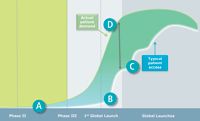Providing Access Now
While regulatory frameworks and medical practices differ between countries, many patients still need early access to new drugs. Industry can help.
All over the world, many patients with serious illnesses can't get access to the medicines they need. The available therapies haven't worked and there are no available clinical trials, or a new drug isn't accessible where they live. For these patients, access to a drug outside of the traditional channels may represent a life-saving treatment option. How can industry help?
Since 1987, FDA-sanctioned "expanded access programs" have enabled patients, under specific circumstances, to access drugs or biologics still in development. Similar regulations exist broadly outside the U.S. but the nomenclature describing these programs differs widely. In an effort to bring much-needed clarity to all of this terminology, we use "Managed Access Programs" as an umbrella term that encompasses a variety of regulatory approaches enabling access to medicines that::
» Are still in clinical development
» May never be approved, but still have medicinal value for a very small population (such as orphan drugs)
» Are approved in one country, but not another
» Have been discontinued in a particular market
» Are an alternative to a drug discontinued globally
Regardless of the nomenclature used, access enabled by these programs can offer significant benefits to patients and their healthcare providers; they're often the only remaining option.
The Need for Greater Access
Patient access to medicines across the lifecycle from Phase I testing through to discontinuation follows a typical pattern (Figure 1-A). The number of patients gaining access grows as the trial process moves forward and continues to increase following first (1-B) and subsequent launches (1-C).
Actual patient demand for medicines that address an unmet medical need (1-D) often exceeds the level of access that is typically delivered. The gap between actual patient access and the total demand for access reflects the fact that not all patients who may benefit from the drug are able to gain access via traditional routes.
Figure 2 illustrates the delay in access that patients in Europe typically experience even after a drug has been approved. Each year, the European Federation of Pharmaceutical Industries and Associations publishes the Patients W.A.I.T. Indicator, which stands for Patients Waiting to Access Innovative Medicines. The data represent all medicines available in 2010 that were approved by the EMA during the years 2007 to 2009.
For those new medicines that doctors can prescribe under national healthcare provisions, the average time elapsing between the date of European Medicines Agency (EMA) market authorization and the "accessibility" date (i.e. date of completion of pricing/reimbursement procedures, represented by the green bars in Figure 2) in 11 European countries varied from 88 to 392 days, not considering Germany and the UK. The orange bars represent the percentage of medicines available commercially in these countries with a valid EMA marketing authorization during the previous three years. This ranged between 39 percent for Portugal to 86 percent for Greece. Even with a centralized marketing authorization, the delay to access can still be significant depending on in which European country a patient lives. These delays are even more profound in other territories.
Managed Access Programs can be used to bridge these gaps, in a fully compliant manner. Such programs can be implemented on a patient-by-patient basis, or for a group or cohort of patients, and are effective at helping companies address patient demand for medicines around the world.
Patients in the U.S.
FDA's expanded access program (EAP) rules were amended in 2009 to ensure "broad and equitable access to investigational drugs for treatment." Regulations include specific criteria for authorization, submission requirements, and safeguards to protect patients and the clinical trial process. The regulations also define the different types of mechanisms that are available, including individual access under a single-patient IND (investigational new drug; or Emergency IND); access for small to intermediate groups of patients; and for larger groups via a Treatment IND or Treatment Protocol.

Single-patient INDs
A single-patient IND is a request from a physician to the FDA that an individual patient be allowed access to an investigational drug. Provisions are also in place to obtain medicines on an emergency-use basis, allowing patient treatment prior to the completion of the requirements for a single-patient IND.

The FDA established specific criteria for when this type of IND may be appropriate. One example is when the drug is not being developed because the disease is so rare, which impedes a company's ability to recruit patients for clinical trials. FDA may also ask the company to consolidate a significant number of single-patient INDs for the same use under an intermediate-size patient population IND. Treatment INDs and treatment protocols provide access to investigational drugs for large numbers of patients who would not otherwise qualify for clinical trials.
Patients Outside the U.S.
Outside the U.S., these access methods are known by a variety of names, including, for example, "named patient programs" (NPPs—in which physicians can request access to drugs on behalf of individual or "named" patients), "compassionate use," and "temporary authorization for use."
Regulations differ widely among countries due to differences in national medical practices, resources available, product funding, hospital structures, and national insurance systems. These programs also allow access, in specific circumstances, to drugs that are approved in other countries but not yet approved in a patient's home country. Additionally, when there is a small patient population spread across a large number of countries (as with a rare disease), a company may be able to offer access to their drug before seeking approval and commercial launch in dozens of geographies that would not otherwise have been feasible.
The thirty countries comprising the European Union (EU)—which fall under the jurisdiction of the EMA—each have their own nationalized regulations regarding access to unlicensed medications for individual patients and patient groups. For example:
» In the UK, the Medicines and Healthcare products Regulatory Agency (MHRA) oversees use and approval of unlicensed medicines. Permission is obtained prospectively, and use is permitted based on a physician's clinical judgment that an individual patient has an unmet medical need and has no suitable alternatives available.
» In France, the French regulatory agency (AFSSAPS) is primarily concerned with the science supporting a request that a patient with a particular indication be allowed access to a drug not approved in France. Additionally, access may be permitted for single patients (Temporary Authorizations for Use; ATU nominative) or groups of patients (ATU cohort) and permission is obtained prospectively.
» In Ireland, the Irish Medicines Board requires tight control on distribution of unlicensed medicines with assurances that the drugs will not be released beyond the intended patients named in NPP requests. Retrospective notification must be completed within two days of use.
» In Germany, Federal Institute for Drugs and Medical Devices (BfArM) oversees access to unlicensed medicines. Historically, the primary mechanism has been via single-patient access. However, in 2010 new legislation was put in place for group access.
Countries outside the U.S. and Europe also offer these programs. Canada's "Special Access Program" provides access to non-marketed drugs to practitioners treating patients with serious or life-threatening illnesses when conventional therapies have failed, are unsuitable, or are unavailable. Similarly, in Australia, patients can access experimental drugs via the "Special Access Scheme." In Japan, government-sanctioned "Named Patient Access" allows access to drugs with an expectation that the drug be approved in the exporting country.
In all of these scenarios, managed access programs provide a route to obtain innovative drugs prior to approval or launch. To support the needs of these patients, companies should proactively consider offering pre-approval or pre-launch access as part of their drug development plan in therapeutic areas with critical or unmet patient needs.
John Lagus is Vice President, New Product and Market Development, at Idis. He can be reached at Jlagus@idispharma.com
Kelly Feam is Manger, Regulatory Information and Intelligence, at Idis. She can be reached at kfearn@idispharma.com
Benefit from industry updates and case studies related to this article at the 5th Annual Congress on Access Programs for Investigational and Pre-Launch Drugs, July 19-20, 2012, Philadelphia, PAcbinet.com/conference/pc12193
Navigating Distrust: Pharma in the Age of Social Media
February 18th 2025Ian Baer, Founder and CEO of Sooth, discusses how the growing distrust in social media will impact industry marketing strategies and the relationships between pharmaceutical companies and the patients they aim to serve. He also explains dark social, how to combat misinformation, closing the trust gap, and more.
